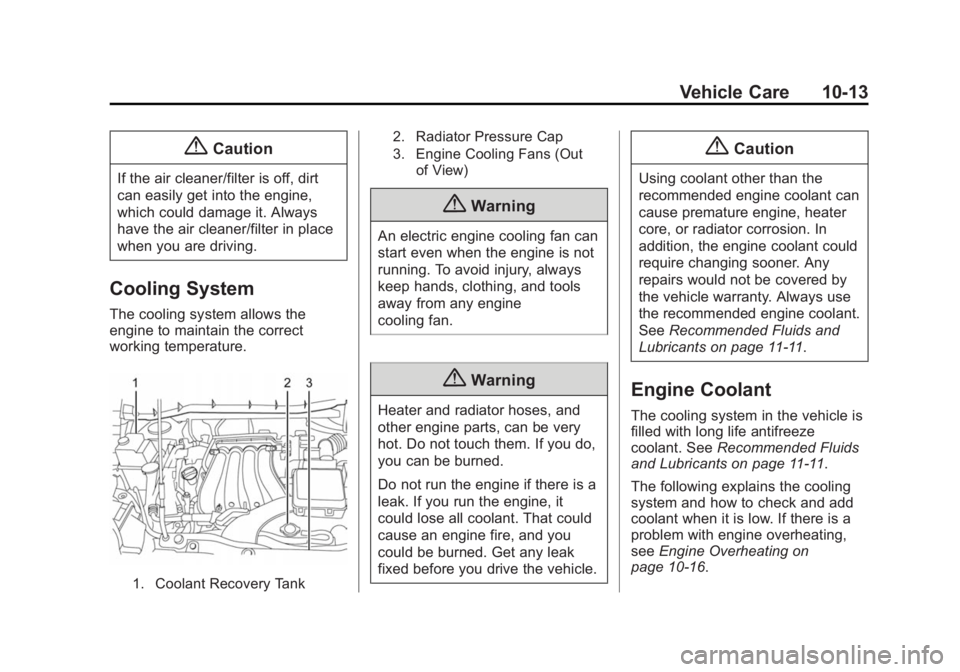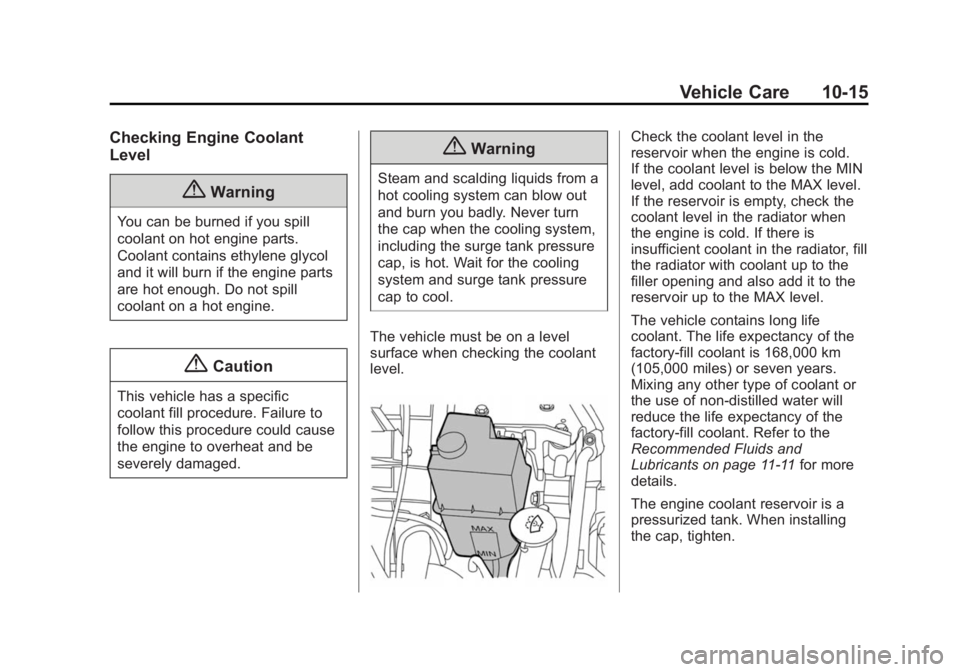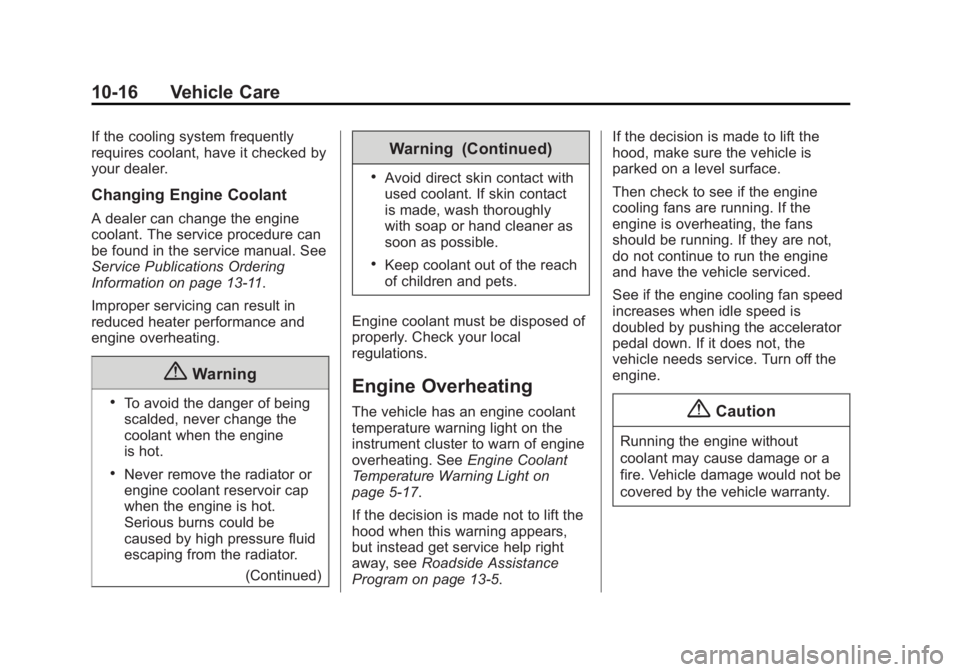2016 CHEVROLET CITY EXPRESS radiator
[x] Cancel search: radiatorPage 191 of 297

Black plate (8,1)Chevrolet City Express Owner Manual (GMNA-Localizing-U.S./Canada-
7707496) - 2015 - CRC - 11/26/14
10-8 Vehicle Care 1. Coolant Recovery Tank. See
Cooling System on page 10-13 .
2. Engine Oil Fill Cap. See “ When
to Add Engine Oil ” under Engine
Oil on page 10-8 .
3. Brake Master Cylinder
Reservoir. See Brake Fluid on
page 10-19 .
4. Engine Air Cleaner/Filter on
page 10-11 .
5. Windshield Washer Fluid
Reservoir. See “ Adding Washer
Fluid ” under Washer Fluid on
page 10-18 .
6. Drive Belt.
7. Engine Oil Dipstick. See
“ Checking Engine Oil ” under
Engine Oil on page 10-8 .
8. Radiator Pressure Cap. See
Cooling System on page 10-13 .
9. Battery on page 10-21 .
10. Engine Compartment Fuse
Block on page 10-25 . Engine Oil To ensure proper engine
performance and long life, careful
attention must be paid to engine oil.
Following these simple, but
important steps will help protect
your investment: .
Always use engine oil approved
to the proper specification and of
the proper viscosity grade. See
“ Selecting the Right Engine Oil ”
in this section. .
Check the engine oil level
regularly and maintain the
proper oil level. See “ Checking
Engine Oil ” and “ When to Add
Engine Oil ” in this section. .
Change the engine oil at the
appropriate time. See
Maintenance Schedule on
page 11-3 . .
Always dispose of engine oil
properly. See “ What to Do with
Used Oil ” in this section. Checking Engine Oil It is a good idea to check the engine
oil level at each fuel fill. In order to
get an accurate reading, the vehicle
must be on level ground. The
engine oil dipstick handle is a loop.
See Engine Compartment Overview
on page 10-7 for the location of the
engine oil dipstick.
Obtaining an accurate oil level
reading is essential:
1. If the engine has been running
recently, turn off the engine and
allow several minutes for the oil
to drain back into the oil pan.
Checking the oil level too soon
after engine shutoff will not
provide an accurate oil level
reading.
{ Warning
The engine oil dipstick handle
may be hot; it could burn you.
Use a towel or glove to touch the
dipstick handle.
Page 196 of 297

Black plate (13,1)Chevrolet City Express Owner Manual (GMNA-Localizing-U.S./Canada-
7707496) - 2015 - CRC - 11/26/14
Vehicle Care 10-13
{ CautionIf the air cleaner/filter is off, dirt
can easily get into the engine,
which could damage it. Always
have the air cleaner/filter in place
when you are driving.
Cooling System The cooling system allows the
engine to maintain the correct
working temperature.
1. Coolant Recovery Tank 2. Radiator Pressure Cap
3. Engine Cooling Fans (Out
of View)
{ WarningAn electric engine cooling fan can
start even when the engine is not
running. To avoid injury, always
keep hands, clothing, and tools
away from any engine
cooling fan.
{ Warning
Heater and radiator hoses, and
other engine parts, can be very
hot. Do not touch them. If you do,
you can be burned.
Do not run the engine if there is a
leak. If you run the engine, it
could lose all coolant. That could
cause an engine fire, and you
could be burned. Get any leak
fixed before you drive the vehicle. { CautionUsing coolant other than the
recommended engine coolant can
cause premature engine, heater
core, or radiator corrosion. In
addition, the engine coolant could
require changing sooner. Any
repairs would not be covered by
the vehicle warranty. Always use
the recommended engine coolant.
See Recommended Fluids and
Lubricants on page 11-11 .
Engine Coolant The cooling system in the vehicle is
filled with long life antifreeze
coolant. See Recommended Fluids
and Lubricants on page 11-11 .
The following explains the cooling
system and how to check and add
coolant when it is low. If there is a
problem with engine overheating,
see Engine Overheating on
page 10-16 .
Page 198 of 297

Black plate (15,1)Chevrolet City Express Owner Manual (GMNA-Localizing-U.S./Canada-
7707496) - 2015 - CRC - 11/26/14
Vehicle Care 10-15Checking Engine Coolant
Level
{ WarningYou can be burned if you spill
coolant on hot engine parts.
Coolant contains ethylene glycol
and it will burn if the engine parts
are hot enough. Do not spill
coolant on a hot engine.
{ CautionThis vehicle has a specific
coolant fill procedure. Failure to
follow this procedure could cause
the engine to overheat and be
severely damaged. { WarningSteam and scalding liquids from a
hot cooling system can blow out
and burn you badly. Never turn
the cap when the cooling system,
including the surge tank pressure
cap, is hot. Wait for the cooling
system and surge tank pressure
cap to cool.
The vehicle must be on a level
surface when checking the coolant
level. Check the coolant level in the
reservoir when the engine is cold.
If the coolant level is below the MIN
level, add coolant to the MAX level.
If the reservoir is empty, check the
coolant level in the radiator when
the engine is cold. If there is
insufficient coolant in the radiator, fill
the radiator with coolant up to the
filler opening and also add it to the
reservoir up to the MAX level.
The vehicle contains long life
coolant. The life expectancy of the
factory-fill coolant is 168,000 km
(105,000 miles) or seven years.
Mixing any other type of coolant or
the use of non-distilled water will
reduce the life expectancy of the
factory-fill coolant. Refer to the
Recommended Fluids and
Lubricants on page 11-11 for more
details.
The engine coolant reservoir is a
pressurized tank. When installing
the cap, tighten.
Page 199 of 297

Black plate (16,1)Chevrolet City Express Owner Manual (GMNA-Localizing-U.S./Canada-
7707496) - 2015 - CRC - 11/26/14
10-16 Vehicle Care If the cooling system frequently
requires coolant, have it checked by
your dealer.
Changing Engine Coolant A dealer can change the engine
coolant. The service procedure can
be found in the service manual. See
Service Publications Ordering
Information on page 13-11 .
Improper servicing can result in
reduced heater performance and
engine overheating.
{ Warning.
To avoid the danger of being
scalded, never change the
coolant when the engine
is hot. .
Never remove the radiator or
engine coolant reservoir cap
when the engine is hot.
Serious burns could be
caused by high pressure fluid
escaping from the radiator.
(Continued) Warning (Continued) .
Avoid direct skin contact with
used coolant. If skin contact
is made, wash thoroughly
with soap or hand cleaner as
soon as possible. .
Keep coolant out of the reach
of children and pets.
Engine coolant must be disposed of
properly. Check your local
regulations.
Engine Overheating The vehicle has an engine coolant
temperature warning light on the
instrument cluster to warn of engine
overheating. See Engine Coolant
Temperature Warning Light on
page 5-17 .
If the decision is made not to lift the
hood when this warning appears,
but instead get service help right
away, see Roadside Assistance
Program on page 13-5 . If the decision is made to lift the
hood, make sure the vehicle is
parked on a level surface.
Then check to see if the engine
cooling fans are running. If the
engine is overheating, the fans
should be running. If they are not,
do not continue to run the engine
and have the vehicle serviced.
See if the engine cooling fan speed
increases when idle speed is
doubled by pushing the accelerator
pedal down. If it does not, the
vehicle needs service. Turn off the
engine.
{ Caution
Running the engine without
coolant may cause damage or a
fire. Vehicle damage would not be
covered by the vehicle warranty.